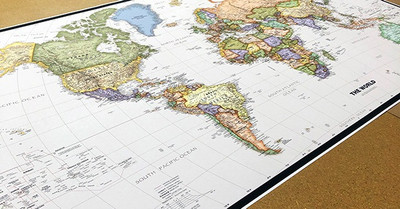Panoramic view map of the city of Milwaukee, with the perspective taken from the City Hall Tower, published by Gugler Lithographic in 1898, reprint. Beautifully colored and detailed, this map captures the city of Milwaukee as it appeared just two years before the turn-of-the-century.
While the region had been inhabited by Native Americans for thousands of years, the first European known to inhabit the area was French fur-trader Alexis Laframboise, in 1785, who established a trading post in the region. The city of Milwaukee can be traced back to a series of trading posts established by French fur-trader, Jacques Vieau, in 1795. Solomon Juneau purchased the trading post that Vieau had established at the mouth of the Milwaukee River in 1820.
During the 1830's, three settlements emerged around this portion of the river, one being a settlement called Juneautown, founded by Solomon Juneau and his new partner, Green Bay lawyer Morgan Martin, who purchased 160 acres of land between Lake Michigan and the Milwaukee River. Land west of the Milwaukee River was purchased by Byron Kilbourn, who founded the settlement of Kilbourntown. South of these two settlements, the town of Walker's Point was founded by George H. Walker in 1835. The three settlements engaged in fierce competition to attract residents and grow their towns. When the Wisconsin State Legislature ordered the construction of a bridge over the Milwaukee River in 1840, it was to Juneautown's advantage. In 1845, Byron Kilbourn destroyed a portion of the bridge. This began what is known as the "Milwaukee Bridge War" which resulted in the injury of several persons involved in skirmishes. On January 31, 1846 the three settlements merged into the incorporated city of Milwaukee, with Solomon Juneau elected mayor. The new city was now the largest in the territory, with a population of about 10,000.
Throughout the 1840's Wisconsin and Milwaukee specifically became the destination of many Germans who were fleeing the political upheaval in Germany and Austria, seeking the freedom and opportunities that were being presented in the newly settled area. Milwaukee had more German language newspapers than English language newspapers throughout the second half of the 19th century and into the 20th century. Polish immigrants also arrived in large numbers, settling mostly on Milwaukee's South Side. There were 138 taverns in Milwaukee as early as 1843, and by 1856, there were more than two dozen breweries in the city. Most breweries were German owned and operated, with names still remembered today such as Pabst, Blatz, Schlitz and Miller.
Features references to the following locations:
Pabst Brewing Co.
Metropolitan Block.
State & Martin St. Bridge.
East Water Street, Looking North.
Chestnut St. & Juneau Ave. Bridge.
Jos. Schlitz Brewing Co.
J. B. A. Kern & Sons Mills.
Market St. Looking North.
White Fish Bay.
Val. Blatz Brewing Co.
Notre Dame Convent.
German & English Academy.
Temple Emanuel.
City Water Works.
North Point.
St. Mary's Church.
Harbor of Refuge.
St. Johns Cathedral.
Milwaukee Co. Court House.
Light Horse Squadron Armory.
Masonic Temple.
C. & N. W. Railway Depot.
County Jail.
Central Station Fire Dept.
Post Office.
Hotel Pfister.
Hathaway Bldg.
University Bldg.
"The Journal".
"Evening Wisconsin".
"Herold".
"Sentinel".
St. Charles Hotel.
East Water St. Looking South.
Rolling Mills, Bay View.
Harbor.
Gas Works.
Mitchell Bldg.
Pabst Bldg.
Chamber of Commerce.
Buffalo St. Bridge.
Huron St. Bridge.
Michigan St. Bridge.
Grand Ave. Bridge.
Oneida St. Looking West.
Plankinton House.
C. M & St. P. Union Depot.
Bijou Theater.
Davidson Theater.
The Alhambra.
"Daily News".
Schlitz Hotel.
"Germania".
Loan & Trust Bldg.
Pabst Theater.
Public Library.
The M. E. R. & L. Co. Power House.
Exposition Building.
Republican House.




